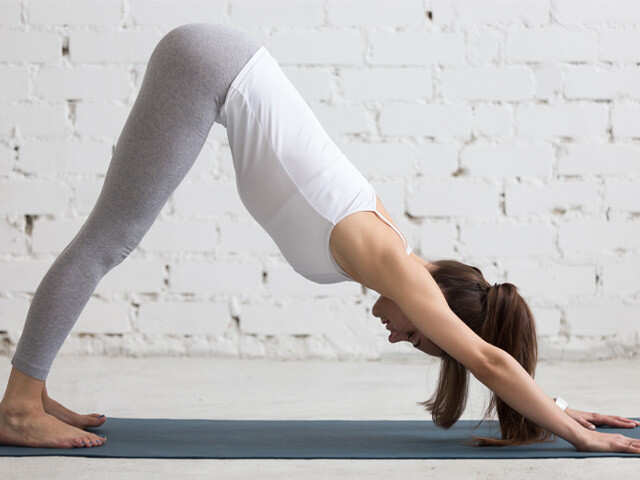
Image: Shutterstock
Adho Mukha Svanasana (Downward-Facing Dog Pose) is a fundamental yoga posture that you will almost certainly practise hundreds of times throughout your yoga journey. Downward dog can help you build better balance and flexibility throughout your entire body because it is equal parts strengthening and stretching. Just be careful not to overdo it: if you have stiff shoulders or hamstrings, the pose may feel difficult. You should be cautious if you're flexible to avoid collapsing in your lower back and shoulders.

This asana can be practised by anyone; even if you are doing it for the first time, you can do it. There are numerous Adho Mukha Svanasana Benefits, and if you practise this asana on a daily basis, you will be able to easily perform and reap all of the Adho Mukha Svanasana Benefits. However, it is critical to perform Adho Mukha Svanasana Asana correctly because incorrect posture can have the opposite effect and cause you to injure yourself. This is true for any exercise or yoga asana.
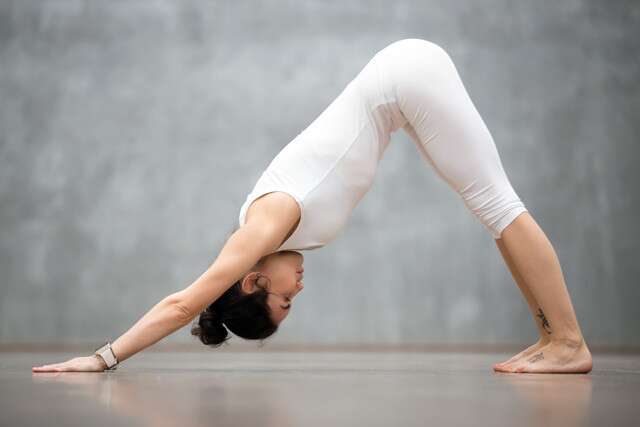 Image: Shutterstock
Image: Shutterstock
Benefits of Adho Mukha Svanasana
How to Perform the Adho Mukha Svanasana
Beginner’s Tip
Variation
Preparatory Poses
FAQs:
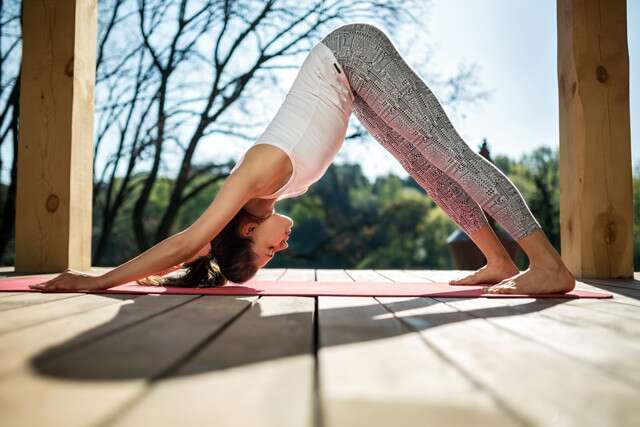 Image: Shutterstock
Image: Shutterstock
Adho Mukha Svanasana is a great way to tone your muscles while also engaging your core. This asana helps to tone the lower abdomen muscles, which helps to reduce excess fat in the lower abdomen area.
Adho Mukha Svanasana is a weight-bearing exercise that helps to strengthen your bones. This asana helps to prevent osteoporosis because it strengthens your upper body, which includes your shoulders.
Stretching your calves and hamstrings muscles while performing this asana will not only strengthen your legs but will also be beneficial to your spine. This asana opens the back of your legs and stretches the muscles in your back legs.
Because your heart is above your head, practising this asana while holding an inverted v position will improve your blood circulation. This asana also improves your concentration and energy levels. If you practise this yoga asana on a daily basis, it will help you relieve neck tension and make you feel more energetic.
This asana is beneficial for increasing the strength of your upper body, particularly your arms. When you practise this asana, you press your arms against the ground, which helps to engage all of the arm muscles and strengthen them.
Some people have terrible posture, and poor body posture causes a slew of issues. When you practise Adho Mukha Svanasana, it helps to improve and correct your body posture, particularly slumpy postures. This asana also helps to lengthen your spine, open your shoulders, and alleviate neck and back pain.
This asana is extremely effective at relaxing back muscles and preventing back pain. When you practise Adho Mukha Svanasana, you stretch your back muscles and increase the oxygen supply to different parts of your body. As a result, your system's performance improves.
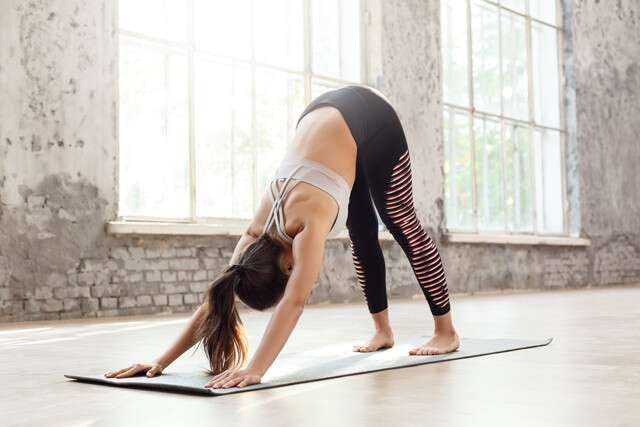 Image: Shutterstock
Image: Shutterstock
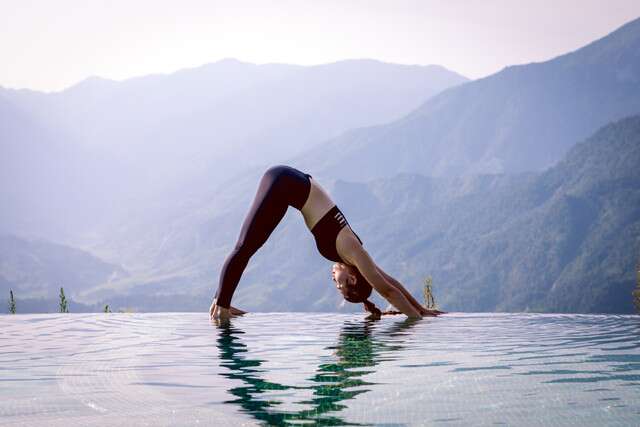 Image: Shutterstock
Image: Shutterstock
Lift slightly up onto the balls of your feet, pulling your heels a half-inch or so away from the floor to stretch the backs of your legs more. Draw your inner groin deep into your pelvis, actively lifting from the inner heels, and then lengthen your heels back onto the floor.
 Image: Shutterstock
Image: Shutterstock
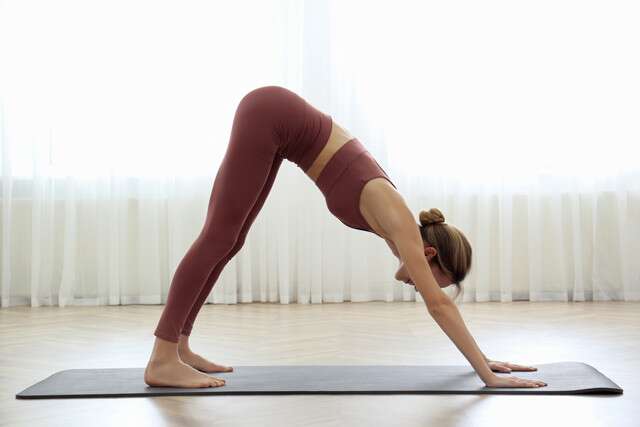 Image: Shutterstock
Image: Shutterstock
Bend your knees in this pose if your hamstrings are tight. If your back is rounded in the position and/or you have low back pain, this can also help.
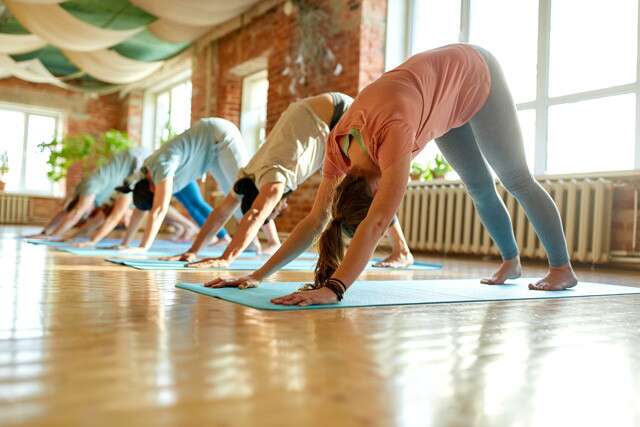 Image: Shutterstock
Image: Shutterstock
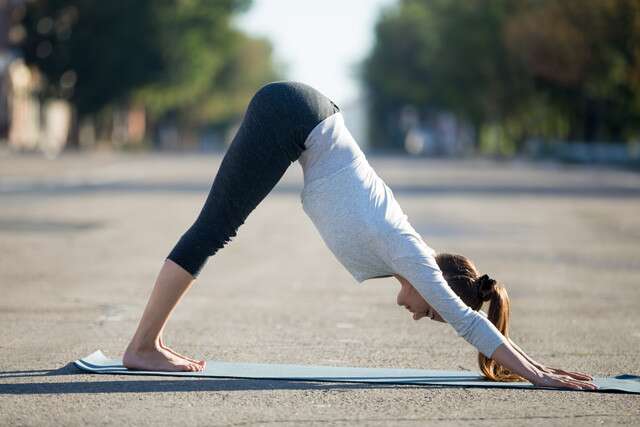 Image: Shutterstock
Image: Shutterstock
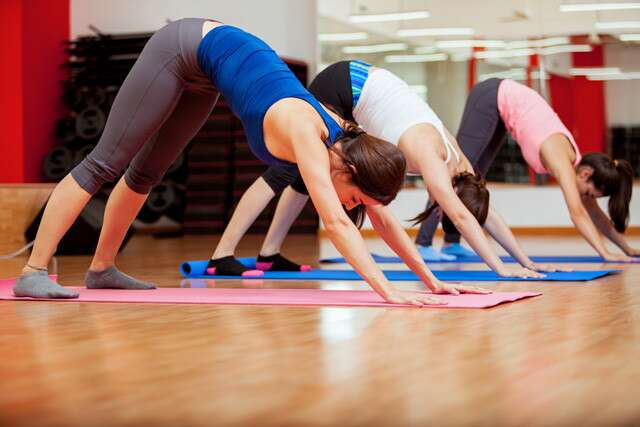 Image: Shutterstock
Image: Shutterstock
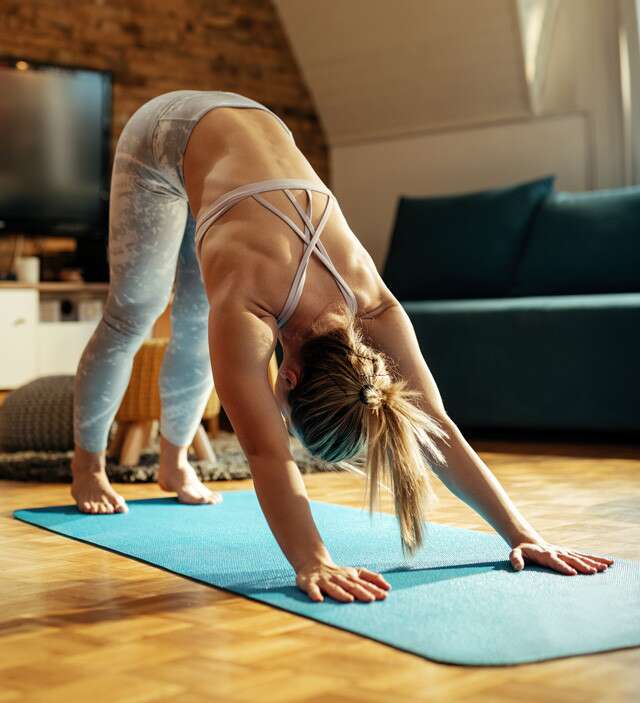 Image: Shutterstock
Image: Shutterstock
Also read: 4 Types Of Berries And Their Benefits You Should Know About
Adho Mukha Svanasana (Downward-Facing Dog Pose) is a fundamental yoga posture that you will almost certainly practise hundreds of times throughout your yoga journey. Downward dog can help you build better balance and flexibility throughout your entire body because it is equal parts strengthening and stretching. Just be careful not to overdo it: if you have stiff shoulders or hamstrings, the pose may feel difficult. You should be cautious if you're flexible to avoid collapsing in your lower back and shoulders.

This asana can be practised by anyone; even if you are doing it for the first time, you can do it. There are numerous Adho Mukha Svanasana Benefits, and if you practise this asana on a daily basis, you will be able to easily perform and reap all of the Adho Mukha Svanasana Benefits. However, it is critical to perform Adho Mukha Svanasana Asana correctly because incorrect posture can have the opposite effect and cause you to injure yourself. This is true for any exercise or yoga asana.

Benefits of Adho Mukha Svanasana
How to Perform the Adho Mukha Svanasana
Beginner’s Tip
Variation
Preparatory Poses
FAQs:
Benefits of Adho Mukha Svanasana

Adho Mukha Svanasana is a great way to tone your muscles while also engaging your core. This asana helps to tone the lower abdomen muscles, which helps to reduce excess fat in the lower abdomen area.
Adho Mukha Svanasana is a weight-bearing exercise that helps to strengthen your bones. This asana helps to prevent osteoporosis because it strengthens your upper body, which includes your shoulders.
Stretching your calves and hamstrings muscles while performing this asana will not only strengthen your legs but will also be beneficial to your spine. This asana opens the back of your legs and stretches the muscles in your back legs.
Because your heart is above your head, practising this asana while holding an inverted v position will improve your blood circulation. This asana also improves your concentration and energy levels. If you practise this yoga asana on a daily basis, it will help you relieve neck tension and make you feel more energetic.
This asana is beneficial for increasing the strength of your upper body, particularly your arms. When you practise this asana, you press your arms against the ground, which helps to engage all of the arm muscles and strengthen them.
Some people have terrible posture, and poor body posture causes a slew of issues. When you practise Adho Mukha Svanasana, it helps to improve and correct your body posture, particularly slumpy postures. This asana also helps to lengthen your spine, open your shoulders, and alleviate neck and back pain.
This asana is extremely effective at relaxing back muscles and preventing back pain. When you practise Adho Mukha Svanasana, you stretch your back muscles and increase the oxygen supply to different parts of your body. As a result, your system's performance improves.
How to Perform the Adho Mukha Svanasana

- Come to your hands and knees, hands slightly in front of your shoulders, knees directly below your hips. Spread your palms and turn your toes under, rooting down through all four corners of your hands.
- Exhale and raise your knees off the floor, keeping your knees slightly bent and your heels lifted off the floor at first. Stretch your tailbone away from the back of your pelvis, lift your sitting bones toward the ceiling, and draw your inner legs up through your groins from your inner ankles.
- Exhale by pushing your top thighs back and stretching your heels toward the floor. Straighten your knees but do not lock them.
- Firm your outer arms and actively press the bases of your index fingers into the floor. Lift your arms from the wrists to the tops of your shoulders. Firmly press your shoulder blades into your back, then widen and draw them toward your tailbone. Maintain a comfortable position with your head between your upper arms.
- Stay in the pose for 10 or more breaths, then exhale and bend your knees to lower yourself into Child's Pose.
Beginner’s Tip

Lift slightly up onto the balls of your feet, pulling your heels a half-inch or so away from the floor to stretch the backs of your legs more. Draw your inner groin deep into your pelvis, actively lifting from the inner heels, and then lengthen your heels back onto the floor.

Variation

Bend your knees in this pose if your hamstrings are tight. If your back is rounded in the position and/or you have low back pain, this can also help.

Preparatory Poses

Cat Pose
- Begin with your hips directly over your knees on the Tabletop. Hands should be shoulder-width apart and slightly ahead of your shoulders. The wrist creases should be parallel to the mat's front.
- Firmly press down with your hands.
- Exhale while rounding your spine toward the ceiling. Drop the crown of your head as well as your tailbone. Pull your lower belly button in and up.
- With your hands, push the floor away from you to widen the space between your shoulder blades.
- Maintain movement in your spine by keeping your hips over your knees and your arms straight.
- Return to a neutral spine to exit the pose.

FAQs:

Q. How much time we should do in adho mukha svanasana?
A. Adho Mukha Svanasana can be held for up to three minutes at a time. It helps to strengthen the abdominal muscles. This asana, in the shape of an inverted V, is also a Navasana variant.Q. Downward facing dog basics.
A. Downward-facing dog stretches the back deeply, opens the chest, and strengthens the upper body. This posture stimulates the brain and nervous system, which improves memory, concentration, hearing, and vision.Q. What is the reflection of downward dog Adho Mukha Svanasana?
A. Some of the benefits of a full inversion are provided by the downward-facing dog pose. Because the head is lower than the heart, fresh oxygenated blood is flushed into the brain, reducing mental fatigue. After Sirsasana, Adho Mukha Svanasana releases the neck and serves as a transitional pose before standing.Q. Who should not do Adho Mukha Svanasana?
A. If you have carpal tunnel syndrome, you should avoid inversions like downward dogs. a late-term pregnancy high blood pressure or other related problems a back, arm, or shoulder injury. If you are unsure whether or not to perform this pose, please consult a medical professional.Also read: 4 Types Of Berries And Their Benefits You Should Know About
Body Mass Index (BMI) Calculator
Next Story